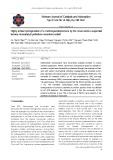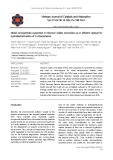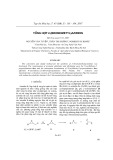
Sodium borohydride
-
Multimetallic nanocatalysts have remarkably revealed activities in various catalytic applications. Herein, the ternary nanocatalysts based on palladiumvanadium-cobalt were successfully synthesized through the reduction of their salts with sodium borohydride including impregnating of activated carbon (AC) substrate with colloid solution of metallic nanoparticles (PdVCo/C).
 5p
5p  vikwong
vikwong
 29-09-2024
29-09-2024
 2
2
 2
2
 Download
Download
-
Titanium oxides nanotubes (TNTs) were prepared by hydrothermal method and used as nano-support for nickel nanoparticles. Indeed, nickel nanoparticles supported TNTs (Ni-TNTs) were in situ synthesized from nickel salt and TNTs by chemical reduction method using sodium borohydride (NaBH4) as reducing agent.
 5p
5p  vikwong
vikwong
 29-09-2024
29-09-2024
 4
4
 1
1
 Download
Download
-
The plasmon characterization of AgNS on paper was systematically investigated by the diffuse reflectance spectroscopy. The fabricated paper-based SERS substrates were used to detect melamine in an aqueous solution and to determine the influence of type RAs on the enhancement factor (EF) and signal uniformity of SERS substrates. Among the four types of RAs, the SERS substrates used NaBH4 have the highest SERS signal with the limit of detection of 10-8 M for melamine and the EF = 2.3 × 109 .
 9p
9p  dianmotminh02
dianmotminh02
 03-05-2024
03-05-2024
 7
7
 2
2
 Download
Download
-
The convenient and simple method for the synthesis of 2-(bromomethyl)aziridines was developed. The condensation of aromatic aldehydes and allylamine gave the N-aryllithene-2- propenylamines 6a-c and the subsequent bromination of N-aryllidene-2-propenylamines 6a-c afforded N-(arylidene)-2,3-dibromopropylamines 7a-c. Finally, The reductive and intramolecular cyclization reaction of N-(arylidene)-2,3-dibromopropylamines 7a-c by treatment with sodium borohydride obtained the 2-(bromomethyl)aziridines in high yield.
 4p
4p  uocvong04
uocvong04
 24-09-2015
24-09-2015
 34
34
 2
2
 Download
Download
-
Propionate CoA-transferase fromClostridium propionicum hasbeenpuri®edand thegene encoding the enzymehasbeen cloned and sequenced. The enzyme was rapidly and irre-versibly inactivated by sodium borohydride or hydroxyl-amine in the presence of propionyl-CoA. The reduction of the thiol ester between a catalytic site glutamate and CoA with borohydride and the cleavage by hydroxylamine were used to introduce a site-speci®c label, which was followed by MALDI-TOF-MS. This allowed the identi®cation of glutamate 324 at the active site. ...
 9p
9p  research12
research12
 29-04-2013
29-04-2013
 30
30
 4
4
 Download
Download
CHỦ ĐỀ BẠN MUỐN TÌM


















